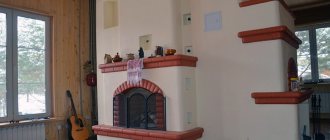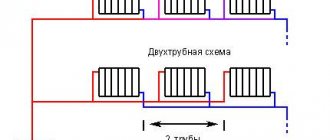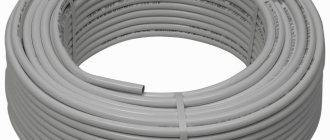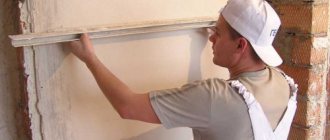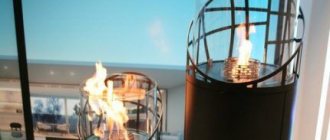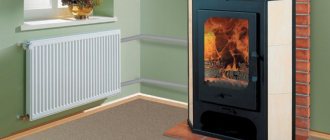Frame construction has a number of undeniable advantages over conventional houses. It allows you to quickly build, does not require special professional skills, and is characterized by the simplicity of the design of houses. In addition, heat saving indicators are high.
In this article we will talk about how to arrange the heating of a frame house, what requirements are imposed on the heating system and which one should be preferred. It must be said that frame houses allow you to organize heating of any type in them - from a traditional Russian stove to convectors.
Heating system for a frame house
There are numerous options for organizing heating in a frame house, which occurs due to the good heat conservation of such types of buildings. Any coolant can be used. The choice of heating system depends on the personal preferences of the home owners and the budget allocated for this matter.
A frame house can be heated:
- Using gas (natural, liquefied), diesel fuel;
- Solid fuel;
- Electricity;
- Systems that receive energy from the earth or the sun.
The best option is to install a combined type frame house heating system. This approach will allow you to heat your home regardless of environmental conditions.
Combined heating may include an electric boiler, a solid fuel fireplace, air heating of a frame house and solar panels on the roof. At night, the house will be heated with water in an electric boiler and in a heated floor system, which will allow the use of a night tariff to calculate electrical energy; in the evening, you can use a solid fuel boiler, and when there is no precipitation, solar panels. In addition, some of the system elements are replaceable with analogues. For example, radiators can be used instead of heated floors, and a gas boiler can replace an electric one.
Single frame frame 9*13 on USHP ~110 m2
The house was built in 2013-2014, wall insulation 200mm, top floor 300-400mm (ecowool), ceilings 3 m.
Heating: gas boiler 24 kW, main gas and only VTP/USHP; House operating mode: permanent residence, ~22 degrees; Average bill for heating in winter: ~1500 rubles per month; Average gas consumption: ~250 m3/month, at the time of publication 1 m3 = 5.97 rubles.
During the winter of 2017-2018, approximately 700-750 m3 of gas was burned, about 200 m3 in December, 300 m3 in January and 250 m3 in February, the readings are not written off from the meter every time. It is also worth noting that the operating mode of the gas boiler (and the choice of its power) in this house could be not the most optimal, maybe there are still ways to optimize.
At the same time, there are additional costs for electricity, which powers all household appliances, kitchen appliances, lighting, etc. day/night figures in kW/h:
- January 2022: 220\154;
- December 2022: 200\120;
- November 2022: 282\190.
That is, another thousand and a half at a city tariff of 4.55 \ 2.62 rubles. (day\night) is spent on electricity - this is the total consumption according to the meter on the fence.
There are also some old statistics from January 2022, when the house was heated with electricity. Total electricity consumption for 8 weeks is 3500 kWh: 2250 day, 1250 night.
2250*3.55 + 1250*2.14 = 10,662.5 rub. for two months (then there were different tariffs). The weather outside in the first month was -2-1-0+1+2+3+4, this is approximately the weather, freezing at night, dripping during the day. At home +21-22. In the second month it was down to -18, about 3 weeks of frost, a week of thaw (no warmer than +2).
During the warm month, consumption was 1500 kW/h, of which 500 at night, 1000 per day or 4,620 rubles. During the cold month, consumption was 2000 kW/h, of which 650 at night, 1350 per day or 6,183 rubles.
There is some information about this house here.
Heating system installation procedure
Before starting work on installing a heating system, you need to decide on its type. Afterwards, you need to draw up a project for placing its elements throughout the house, purchase the necessary equipment and materials for installation.
Thanks to the frame structure, laying heating pipes can be carried out at the very end of construction work. But if you don’t want to disassemble the wall cladding, then you should think about the heating system in advance.
As a rule, heating pipes are mounted on top of the frame and finishing; placement between the wall and sheets of drywall is often found. The external option is preferable, since it will not be necessary to perform any actions with the structure of the house, and access to communications will also be provided in case of their breakdown.
If you plan to install a combination boiler, you will need to strengthen the foundation under its location in advance, since the unit has considerable weight. In addition, it is necessary to consider a fire extinguishing system in case of an emergency. In this regard, a combination boiler is a rather problematic option.
Installation of skirting models
Installation work is similar to the installation process of classic models. Please note the following before installation:
- Mounting height. The minimum permissible distance from the floor should be 0.15 m. At lower values, the efficiency of the heating installation decreases.
- Installation location. It is forbidden to install products behind furniture - after prolonged use, the furniture structures dry out. The convector must not be covered with decorative partitions or recessed in wall niches; it is also unacceptable to cover the device with fabrics, because circulation of air masses must be ensured.
- It is necessary to provide a separate RCD and grounding for the equipment.
If these standards are met, installation will not be difficult, because Convectors are supplied assembled, ready for use. Skirting convectors can be connected to the network either in series or as a collector.
Skirting models are used for heating apartments, residential buildings, cottages, administrative buildings and industrial workshops.
Electrical heating
Heating for a frame house using electricity is a fairly popular option, but the cost of constantly heating the building with its help is relatively high. Its installation does not require obtaining any special permits, it can be carried out in any conditions, and there is no need to spend money on consumables.
The electric boiler is installed according to the rules for installing any other electrical equipment. Wiring is calculated based on the power of the equipment with a reserve for overloads and requires reliable insulation.
Convector ADAX VP 1020 KT
Photo: https://beru.ru
The VP 1020 KT model has a decent power of 2000 W. The heating element is a heating element with enhanced heat transfer due to the presence of special ribs. The thermostat is mechanical, there are markings in the form of numbers on the handle. The range of temperature settings is from 5 to 35°C. The overheating protection system ensures user safety and long-term operation of the device itself.
Convector ADAX VP 1020 KT
Advantages:
- Quiet operation, no oxygen is burned
- Wall mounting bracket included (legs optional)
- the surface does not heat above 75°C
Warm floor
The underfloor heating system is installed on subfloors. It is first necessary to install a vapor barrier on the surface to protect the floor from moisture. Next, heat-reflecting material is laid to prevent heat dissipation, after which heating mats are laid. Finally, finishing and installation of heated floor control systems are carried out.
The advantage of the solution is that warm air rises up from the surface of the floors and is distributed throughout the entire space of the room, and cold air falls to the bottom, where it also warms up.
Electric boiler
You can install an electric boiler yourself, but a number of nuances should be taken into account:
- The cross-section of the wires must comply with the requirements specified in the documents for the equipment;
- The switch may only be placed in the same room as the boiler;
- If you plan to use a boiler, then it should be located above the electric boiler;
- Wiring in a frame house must be done in advance;
- Installation of electrical equipment requires strict adherence to safety precautions in order to avoid electric shock;
- The boiler must be regularly inspected for leaks and damage to the insulation.
Permits
Unlike installing a solid fuel boiler in a wooden house, gas equipment requires a permit. To do this, you need to contact the local organization responsible for gas supply - Oblgaz or Gorgaz. Connection to the gas main should only be carried out by certified specialists, but installation of boiler equipment can be done independently.
Stages of obtaining a permit:
- Obtaining technical conditions. It indicates the requirements for connecting to the gas main. It is necessary to provide a house plan with its characteristics.
- Drawing up a gasification project. This work is performed by specialized licensed organizations.
- Based on the project, permission is issued to install a parapet boiler in a wooden house. The same applies to wall-mounted or floor-standing models.
- After installation, representatives of the gas service must check the building and the main line for compliance with the technical conditions and the agreed project. They also connect the equipment to the pipeline.
To optimize time and financial costs, it is recommended to use the services of Gorgaz subsidiaries. Their representatives know the nuances of design and the latest changes in requirements for premises and equipment.
Gas heating
Heating a frame house with gas is the most popular method. A gas boiler has long served as a reliable source of heat in the house.
It should be noted that gas supply to the house is not so fast and not so simple. You will first need to obtain permits from various authorities over the course of several months.
Gas heating can be installed only with the help of special equipment, which is not cheap. Installation and commissioning work is just as expensive, which is why many people prefer electric heating systems.
However, if we consider the long term, gas heating will be much cheaper than other types of heating. The low price of gas covers the cost of installing equipment. In just a few years, you will “recoup” all the money spent.
Results
Convector heating is a very good option for heating rooms. Convectors can be recommended for installation both in small apartments and in large country houses. They have good performance and efficiency.
Homemade - this word means that the product is made with your own hands, but sometimes it is used with some kind of disparaging connotation. Yet this is far from the case. The most expensive hand-built cars in the world are created according to individual projects. What should we call them? Homemade? Everything that ensures the life of mankind is created by human hands.
The topic of this article is homemade products for heating a house, but its goal is not to teach, but to give an overview of those homemade options that talented people implement. Of course, self-production requires certain knowledge, experience, tools and materials for the job. Only in this case is it possible to produce a high-quality and safe heating device no worse, and in many cases even better, than industrially produced boilers.
Most often, craftsmen begin creating a heating system by determining the type of boiler, creating drawings and then constructing the boiler. This work is not easy, therefore, without good knowledge of the structure and operating principle of the selected type of boiler, experience, availability of the necessary tools and materials for its installation, it is difficult to complete it.
Most often, the following types of boilers are manufactured independently:
Gas boilers are difficult to make on your own, since this is high-risk equipment and is subject to special technical requirements. Attempts to make a homemade one are limited by the need to obtain a quality certificate and permits from supervisory authorities. It is problematic to pass all the required checks for compliance with quality parameters. But repairing a convector with your own hands is acceptable. Most often, the central pipe of the coaxial output burns out and it can and should be replaced.
Electric boilers
Boilers of this type are characterized by extreme simplicity and low safety requirements during installation. An electric boiler can be compared to conventional electrical appliances that are used in the house. The only drawback is the high and constantly increasing price of electricity. But for a garage or cottage, if it turns on occasionally, it will be quite suitable.
Liquid fuel boilers
Boilers using liquid fuel are also easy to manufacture. An obstacle to production can be the high price of injectors.
Solid fuel boilers
This class of boilers, and they are divided into wood, pyrolysis and pellet, is the most popular for self-production. A do-it-yourself wood heating boiler is one of the simplest and cheapest, but its efficiency is quite low. There are many drawings and practical tips on the Internet for making a boiler of this type. A wood-burning boiler can operate on any type of solid fuel.
Pyrolysis boilers
Two-chamber pyrolysis boilers are quite expensive to manufacture on your own. They have two combustion chambers. In one, fuel burns with minimal access to oxygen. That is, the process of pyrolysis or dry distillation of wood occurs. The gas released from the wood burns in the second chamber, releasing a large amount of energy. A pyrolysis boiler can operate on wood, coal and peat.
Craftsmen have learned how to make a pyrolysis boiler from a gas cylinder with their own hands, which is economical and works great. The easiest way to make a boiler is from a gas cylinder with a capacity of 50 liters.
(no votes yet)
Stove heating and fireplaces
Heating a frame house without using gas can be done using a stove or fireplace. Since time immemorial, people have loved to look at fire, which gives a feeling of coziness and comfort. Modern solutions offer many ways to contemplate “live” fire. Their use makes it possible to create a feeling of comfort in the house, and the fireplace itself can act as a heater.
Among the advantages of a fireplace are high heat accumulation and its uniform distribution. The materials for making fireplaces are presented in a wide range, so everyone will find something to suit their taste. Of course, fireplaces are not without their drawbacks. The most tangible is the need to purchase firewood to keep the fire going. In addition, when using it, it is very important to follow fire safety rules.
An alternative option is stove heating of a frame house. If you constantly add firewood as needed, the stove will maintain the required level of heat in the house for a long period of time. In addition, the premises will be heated already five minus after kindling. There are also very different options for the implementation of stoves; the unit can be placed in a corner, near a wall and in other places. In addition, the oven can be used for cooking food.
Installation of a gas wall-mounted boiler - kitchen requirements
- Ceiling - 2 meters and above.
- The total volume of the kitchen is more than 7.5 m3, ventilation is equipped, a window is installed and there is a door opening onto the balcony.
- For air exchange, it is necessary to install a grille at the bottom of the wall or door that opens into the next room; the area of the grille is at least 0.02 m2.
If the kitchen in the apartment does not meet the requirements of SNiP, then gas heating equipment can be installed and operated only with the permission of the gas supervision authority.
It is strictly forbidden to install more than 2 heating devices or more than 2 boilers in one room if the volume of the room is less than 7.5 m3
The existing rules for installing a gas boiler in a private house largely repeat the requirements for boilers that operate in apartments in multi-storey buildings. The differences are caused only by the fact that often in a private house a separate room or building is allocated for heating equipment, which is subject to additional requirements listed below.
Using a solid fuel boiler
Heating for a frame house using a solid fuel boiler is the best option for houses without gas supply. It allows you to use a wide variety of raw materials for heating - firewood, peat briquettes, wood and paper production waste. In a solid fuel boiler, not only the raw materials themselves are burned, but also the gas released during the process, which can significantly increase the efficiency of the equipment.
The principle of operation of a solid fuel boiler is as follows: through the heat exchanger pipes in the boiler, the air mass is heated, which subsequently enters the premises of the building. The convection process makes it possible to increase the temperature in the house to the required values within a short time.
Equipment operating on solid fuel supports several operating algorithms:
- Stage-by-stage heating of the house;
- Fast heating;
- Maintains the set temperature for 12-15 hours.
Electric convector EVUB-2.0
An example of a reliable and efficient convector is the domestic electric convector EVUB-2.0. Main characteristics of this convector:
- nominal power 2.0 kW;
- nominal voltage 220 V;
- dimensions 1095 x 405 x 80 mm;
- weight no more than 8 kg;
- quantity of heating elements 3 pcs.
The EVUB-2.0 convector is designed for additional heating of residential premises. The thin body of the convector has a white polymer coating. The heating element inside heats the air entering through the slots at the bottom. The heated air leaves the convector through the upper slots on the front side. The convector is equipped with an emergency shutdown sensor and a temperature sensor, which is used to regulate the temperature in the room.
Features of operation
Basic operating requirements:
- The EVUB-2.0 convector is designed for long-term operation without supervision, subject to installation rules.
- The heating effect will be greater if you install the convector at a height of up to 1 ton from the floor or under window openings.
- The converter must not be obscured by objects, furniture, etc. at a distance closer than 0.1 m.
- The convector can only be operated with an RCD (residual current device). It is possible to work in a network that has protection against overload and short circuits for currents up to 16A.
Nuances and conclusions
To ensure maximum effect from the heating system, the frame house must be properly insulated. At the same time, not only floors and walls require thermal insulation. According to research, the greatest heat loss occurs through ceilings. To avoid this, you need to insulate not only the ceiling, but also the attic space, if there is one in your house.
This concludes our review of the most popular options for heating a frame house. Any solution has its own list of pros and cons. When choosing a heating system, you should take into account the area of the building, whether it is possible to supply gas and other nuances. However, the most rational option would be to use a combined type of heating.
Innovative design of heating elements
All devices in the new line of Ballu convectors are equipped with patented heating elements made using HEDGEHOG technology. And this is what this means: thanks to the special geometry of the heating elements, the heat transfer area of the device increases by 20%. This improves the performance of the convector and increases the speed of heating rooms by an order of magnitude (in comparison with similar devices from other manufacturers).
In general, the unique shape of the body and fins of the heating unit allows you to spend 30% less time heating rooms of the same volume. At the same time, spaces with excess temperature do not form inside the device, which prolongs the service life of the equipment and prevents overheating of its outer casing.
The safety of Ballu convectors is confirmed by the certificate of conformity of the Ministry of Emergency Situations, and their quality is confirmed by the impeccable reputation of the manufacturer.
Let us highlight the main advantages of Ballu convector heating systems:
- Economical
- Safety
- Efficiency
Here you can add undeniable benefits regarding construction and operating costs. Of course, we must not forget about the possibility of equipping the device with a WI-FI module, which allows you to control the convector through an application from anywhere in the world, maintaining the specified temperature in the house in your absence.
We remind you: by choosing innovative solutions from trusted manufacturers, you are one step ahead of those who sincerely want to save money, but still benefit from the technical advances of previous decades.




